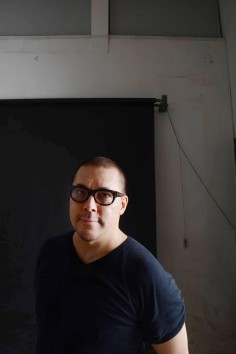
Nigel Reading's groundbreaking buildings may be coming to Hong Kong
Architect's interest in ancient Greek geometry led to a new way of thinking about design - now his work may be coming to Hong Kong

It's not often that an architect is invited to speak at a science conference, but Nigel Reading isn't your average architect.
Born in Hong Kong, raised in Australia and educated in Britain, Reading is a colourful character with a quirky take on life. His offbeat approach feeds into his work, and if things go his way we might see one of his otherworldly structures built in Hong Kong.
The science conference was in October. It was the 8th Constructal Law Science Conference at Nanjing University, and Reading was invited to present the asynsis (asymptotic synthesis) principle, a theory he began working on as a student in 1991.
At the core of his work is the "golden ratio", a term that used to describe aesthetically pleasing works of art and architecture.
But it's more than just a term, it's an actual ratio. In its most simple form, the golden ratio, expressed by the Greek letter phi, is 1.618... It's hard to not think of Egypt's ancient pyramids and Greece when we think of the golden ratio, and that's precisely where Reading's fascination began. It's a ratio deeply embedded in many works of art and architecture.
At the age of 21, he took a couple of years off before he began university, bought a motorbike and toured Europe, Egypt and the pyramids.

The holiday over, he began a BA in architecture at Kingston University. His time in Greece had left a big impression on him and, when it came time to produce a thesis at the end of the three years, he proposed that the golden ratio was also embedded in chaotic systems.
At this point, the proposal was little more than an idea, but he got the chance to prove it over the next four years. He enrolled in a diploma in architecture at Westminster University and had the good fortune of finding a class on chaos and fractal geometry on offer. It was a chance to put his theory to the test.
"It was just dumb luck that the university happened to have a unit on fractal geometry and chaos theory, so I could show that the golden ratio was embedded in chaotic systems and I produced my history and theory thesis for Westminster with quite a lot of maths," says Reading.
Much of his research involved the flow of mass and energy. He called his work "dynamical symmetries" and later "asynsis". He wasn't sure if his findings were important. His professor passed him with good grades, but he says he had the sense he had stumbled onto something significant, so he pitched his research to Architectural Design magazine. It published a story on his work in its November 1995 issue.
After that, it was time to put asynsis to work in the real world. Reading worked as an architect in London for a number of years before moving to Asia. In Asia, he was part of a team that worked on a number of big projects, including the City of Dreams and Galaxy in Macau and a Kerry Group property in Shanghai.
He never forgot his asynsis principle; it had always been at the forefront of his work. The design that he says best encapsulates his theory is Hong Kong Spin, an unbuilt horizontal Ferris wheel which takes the form of the Greek letter phi. He first proposed the project years ago for the end of the Kai Tak runway and is holding out hope that it will be built in West Kowloon.
At the heart of the asynsis principle is the notion that beauty in design is a direct analogue of sustainability and optimisation in nature. When it comes to architecture, this means green buildings, both inside and out.
So for the Kerry Parkside project he worked on in Shanghai, this translated into Reading pushing for LEED Gold certification, the benchmark for green buildings.
The lighting on the LED curtain walls in the four towers at the City of Dreams in Macau encapsulates the "form follows flow" of the asynsis principal. He says he originally proposed the idea for W-Square in Wan Chai, but budget issues meant it wasn't used. The idea was later adopted by the City of Dreams.
Then, in 2012, a book was published that rocked his world. Design in Nature: How the Constructal Law Governs Evolution in Biology, Physics, Technology and Social Organisation, written by a professor at Duke University in the US, seemed to echo many of Reading's own assumptions and ideas. Reading contacted Adrian Bejan at Duke and told him he "may have discovered something similar".
"I was lucky enough to have encountered this principle and published it two years before they did, and precedence is important in science. They could have said, 'Oh, we don't want to share our good fortune in having made this discovery', but they took an enlightened approach," says Reading.
They met for lunch. By chance Professor Bejan and his colleagues were coming to Hong Kong. They sat down and compared notes.
"We realised that we had discovered two sides of the same coin. They had discovered thermodynamic behaviour, heat and how heat flows to create shapes, patterns.
"I had discovered the patterns and the rules behind the patterns," says Reading, who also teaches at L'Ecole de design Nantes Atlantique in Shanghai.
"When you go down to a fundamental level, aesthetic rules apply equally to art and science.
"We agreed to explore ways to work together in future to promote the better understanding of this principal to help society flow more easily, to be more efficient and more aesthetically pleasing."